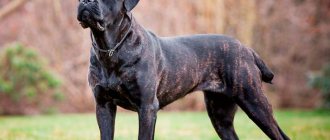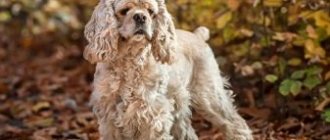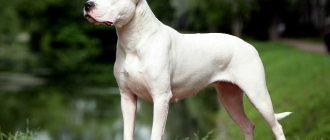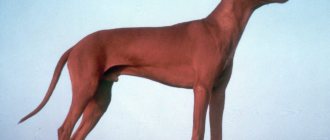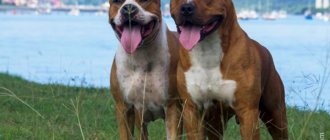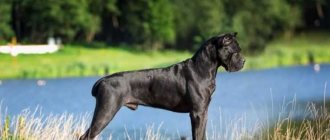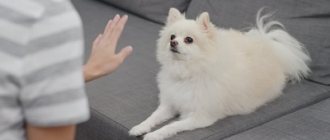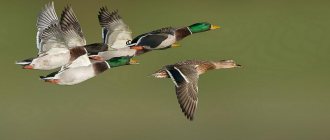Brief history of origin
A bright representative of the breed
The Bull Terrier breed owes its origin to the Englishman John Hicks. It was he who, in 1850, set himself the goal of breeding a new fighting type of dog with unsurpassed qualities.
The breed was based on white English terriers, which, unfortunately, did not survive to this day; the breed disappeared. English bulldogs and Dalmatians also took part in breeding the breed.
After 12 years of breeding work, in 1862 the white bull terrier first appeared at the exhibition and immediately attracted the attention of dog breeders with its physical shape and fearless character.
For reference! Another dog used in fighting was bred from the English Bulldog - the French Bulldog. The dog gained great popularity in France. Sometimes it is also called the French Bull Terrier.
Meeting of two friends
Bull Terrier - description of the breed
What a bull terrier looks like depends entirely on the owner. The dog initially has good physical shape.
- In order for a bull terrier to be pumped up, he must constantly train, jog, jump, and play outdoor games.
- Without physical activity, the bull terrier becomes lazy, quickly becomes fat, and its character changes for the worse.
- Only proper upbringing will help to subordinate it to its owner and make it obey unquestioningly.
Bull terriers are so popular among the population that they are featured in films (101 Dalmatians, The Mask), in beer advertisements (Budweiser), and companies produce clothing items with photographs of bulls.
The great popularity of large bull terriers inspired breeders to create a miniature bull breed. They achieved this by crossing Jack Russell Terriers with small Fox Terriers.
In 1938 the breed received recognition. Its main colors were black, red, fawn, red, brown, and brindle. Despite their difference in height, both belong to the same breed.
Two representatives of the same breed, big and small
Breed standard
The first bull terrier standard was pure white. It was he who was registered by the Kennel Club of England. Different coat colors became possible only at the beginning of the 20th century. Now pure white individuals with spots on the head, two-color, tri-color, and brindle colors are allowed for breeding.
Important! Whatever color the Bull Terrier dog is, its eye color should be dark brown. Light color is considered a defect of the breed.
White Bull Terrier Standard
Bull Terrier characteristics, color and coat type
Bull Terriers have a short, smooth coat. Prolonged exposure to the sun can cause them to burn. It is also unable to protect the animal from the cold. The breed standard provides for the following indicators:
- the skull is egg-shaped, the head is set low;
- eyes - small, triangular in shape, deep-set at a considerable distance from the bridge of the nose;
- nose - slightly curved downwards with a black lobe at the end, with well-developed nostrils;
- ears are small, with a vertical, low set;
- teeth - strong, large with a scissor bite;
- the body is powerful, with well-developed muscles;
- chest - wide, muscular;
- tail - horizontal, low set, medium length;
- paws - the length should match the width of the chest;
- height - 44-50 centimeters at the withers with a weight of 26-40 kilograms.
The most common bull terriers have pure white coats. These also include those that have spots of different colors on the head, the main thing is that they do not fall below the level of the neck. The spots can even be of different colors, for example, black monocles on the face and red ears. The spots on the body change the color name to white with markings.
Note! The red bull terrier has hair all over its body of the same color without any inclusions.
The color can have different shades up to dark brown. Very light red is already a fawn color. This color is not welcome among dog breeders.
Pure black coat color is extremely rare. It is often mixed with white paws or a white shirtfront on the chest. This color is considered two-tone. All individuals that have 2 colors in their color are considered bicolor, regardless of where they appear. All their names are written with a dash, black and white, red and white.
Different colors of the breed
Tricolors consist of white, red and black colors. Moreover, shades of red should be in the smallest quantities, white should be within 50%, mainly black predominates in color.
Tiger bulls did not immediately gain recognition; they had to fight for this color. The predominant species are beautiful red ones with dark stripes, but there are also black ones with red stripes.
Brindles with white patches on the muzzle are called brindle-white. But in the absence of such, even if there are areas of white fur on the body, the name remains the same, it is still a brindle color.
Additional Information .
Blue, gray, fawn colors are considered defective and are not allowed for exhibitions or breeding.
Maintenance, care and nutrition
An important characteristic of a mini bull terrier for any breeder is ease of care. The animal is clean, the owners do not have to clean the fur from the furniture.
It is important to accustom puppies to the litter box immediately after bringing them into the house: choose a permanent place for it, line it with toilet paper, put the dog in it in the morning and after feeding, keep it in one place until it empties. The vaccinated bull should be taken outside. However, “toilet chores” should not replace a full walk.
Nutrition
These dogs are allowed to be fed with natural food, canned food, and granular formulations. The main condition is to take premium food that does not harm the health of the animal. Natural foods include lean meat and offal; the protein component should be mixed with cereals and chopped vegetables. Sometimes it is useful to give fermented milk products without sugar and add vitamin supplements to the food to keep muscles and bones healthy.
Food is given to the dog in accordance with the following rules:
- She should eat strictly at one time, ideally when she comes from the street;
- after feeding, the animal should be allowed to rest;
- putting too much food in a bowl and serving between meals is not allowed;
- There should always be clean water in the drinking bowl.
Dwarf bull puppies are fed 5 times a day, after three months - three times, after a year - twice.
Under no circumstances should you allow your dog to pick up food from the ground: the animal may choke on a bone or get poisoned!
The mini bull terrier will not sleep outside in an enclosure: it is kept in the house, placing a bed closer to the owner. It should not be placed near the front door: the animal will get cold due to the draft. The thickness of the bed should be sufficient to keep the dog warm, and from it he could see the whole room.
Care
Since miniature bull terriers are clean animals, hygienic care for them is basic.
The animal is combed once a week and bathed 1-2 times a month. Between baths, the coat is wiped with a dampened towel if necessary. No specific care is required for the claws: if you walk the animal every day, they will wear down on their own, but once a month you can look at their condition. Once a week, the dwarf bull terrier's ears are cleaned with a sponge, they are checked for ticks in the auricle, and their teeth are brushed every week using a special tool.
Walks
This energetic dog loves to go for long walks (2+ hours) outside. Before leaving the house, she should wear a strong leash to prevent escape or attack. It is advisable to engage the animal in physical exercise.
Puppies under 8 months of age are not seriously trained due to the softness and immaturity of the joints. Adult dogs must be forced to run and overcome obstacles. For winter, it is recommended to purchase overalls: these animals do not have undercoat. Suitable toys include cast rubber balls and rubber bones, durable frisbees, and sticks.
Pros and cons of the breed
The main disadvantage of the bull terrier is the prejudiced attitude of people towards it. Many people mistakenly believe that aggressiveness is genetic.
Yes, they are leaders by nature, hunting for small animals is in their blood; if you anger them, you can see a terrible grin in their mouth. But in a purebred dog, all this is compensated by good upbringing.
Important! This jock is safe for humans. Most terrier owners note their kindness, loving nature and cheerful disposition.
Even when guarding his master, he will never be the first to attack the villain. The dog does not require much grooming; its short fur can only be wiped with a damp cloth.
A dog can be surprisingly cute
Character and behavioral characteristics
Bulldog Terriers are unreasonably considered only aggressive dogs. The dog poses danger only to his own kind; he was made that way on purpose. He poses no threat to people; he is not initially evil.
Attitude towards children
The Bull Terrier has a cheerful character, despite everything that is commonly said about him. He will happily play with children at any age. He is open and friendly in the family. A well-trained dog knows how to behave both at home and on the street.
Why is a bull terrier dangerous?
The bull terrier breed has excellent intelligence and intelligence, but it is initially inherent in the desire to win at any cost. The standard bull terrier feels almost no pain, is very brave and resilient. But the main quality of this dog is that the description of the bull terrier breed includes a bulldog grip.
It is very difficult to separate two fighting dogs. Neither kicks nor a water shower will help here. In order for the dog to lose the ability to fight, you must try to tighten the leash of one dog as much as possible, while at this time a scarf or belt, or any noose that is at hand, is thrown around the neck of the second dog.
You can try to sharply lift the back of the bull terrier off the ground. Having lost his support, he loses the ability to fight. Trying to open its jaws manually can result in serious bites. They can only be unclenched by cutting off his air by squeezing his throat.
A properly trained bull terrier will not even touch a cat.
Dog character
Explosive character is the main feature of these dogs. The Bull Terrier is distinguished by its strength of spirit, activity, excellent fighting qualities and endurance.
Their irrepressible temperament sometimes forces the owner to be more active than he would like.
A dog must undergo training from childhood. Moreover, it is better to entrust this to professionals. She must also understand the harsh hand of the owner, so that in the future there will be no difficulties in everyday life. This does not mean that a dog owner should be cruel or abusive towards a Bull Terrier. Dogs remember this behavior, stop trusting their owner and may even harbor a grudge. During the training process, the dog should not see dramatic changes in the owner’s character.
The family behaves very friendly. They love to play, which brings joy to children. But you shouldn’t leave bull terriers alone with children, because no one knows how much patience a dog has with respect to the pranks of children. They often show feelings of jealousy.
The dog is very brave by nature. That is why during walks she easily goes on the offensive against other dogs, even larger than herself, or suspicious passers-by if she believes that there is a threat to family members or the owner.
In order for the Bull Terrier to splash out its energy, it is necessary to take long and active walks with it. These must necessarily be walks with elements of training or games, otherwise he will try to realize himself in the home space.
May behave differently with other pets. There are cases when bull terriers even looked after kittens and puppies from other dogs. For the most part, it is not recommended to have pets other than a bull terrier. Or you should at least get a bull terrier last so that he has no desire to defend his territory.
Nutrition and care
Dogs of this breed do not cause their owners much trouble in caring for them. Procedures for combing wool - usually using special rubber gloves - are best done once every two days, then it is guaranteed that no hair hairs will appear on the floor or objects in the apartment. Even during the period of active shedding, falling hair does not cause much inconvenience.
Dogs benefit from brushing with a stiff brush, as this allows them to achieve a massage effect. The muscular body of Bull Terriers requires that the muscles be toned and receive sufficient nutrition through the blood.
It is not customary to bathe a dog. They do this only if absolutely necessary. Claws are usually trimmed once every two weeks with special pliers.
It is recommended to feed your dog twice a day. The second feeding should not be too late. It is better to give food after a walk.
Her diet should contain a lot of protein foods. An adult dog is quite capable of handling raw meat (preferably beef), steamed liver or other offal. It is not recommended to give milk; it is better to replace it with kefir and cottage cheese. It is useful to give porridge, because they well compensate for energy costs. You should organize your dog's feeding in such a way that it does not bend too much towards the bowl.
When feeding your dog dry food, you need to constantly keep a bowl of clean water so that the dog consumes enough liquid.
If the potential owner is confident in the strength of his character, then he can adopt a bull terrier without a doubt. This dog can become his faithful companion.
Training and education
When purchasing a dog of this level, you need to thoroughly know everything about bull terriers and be especially careful in their training, which should be based on love for the pet, and not cruelty.
It is very difficult for timid, inconsistent people with an unstable character to cope with such dogs. A subconscious fear of animals also interferes with their upbringing. You need to start raising a puppy with socialization, by getting to know other puppies, cats, and children.
Bull with his toy
It is necessary to teach the puppy to play together and stop any aggression on his part. If the baby is tired, the training is interrupted. The puppy is rewarded with a treat for following commands; those that fail are not punished. They will return to their implementation later.
Note! You cannot provoke any dog into aggression by taking away things that belong to it. She will defend her property, which could end in tragedy.
Training can begin at six months. First, they are taught to perform simple commands, and gradually they are given the concepts of all basic commands, achieving their unquestioning execution. The dog must listen to the owner's commands without being distracted by external stimuli. This is especially true for prohibiting commands.
The Bull Terrier requires a lot of physical activity, constant training, or at least long walks with active games. Dogs do not like loneliness, quickly become attached to people even in adulthood, are endlessly devoted to their family, and are sociable.
The characteristics of the Bull Terrier breed largely depend on the purity of the blood and quality control of the mating. Free, uncontrolled crossing leads to the fact that breeders, in pursuit of the ruble, pay attention mainly to the fighting qualities of the dog, instilling in them unreasonable aggression. They, in turn, produce the same offspring. A purebred, well-bred dog cannot be aggressive towards others.
Additional Information . The basis of raising a bull should be love, and in no case cruelty. Then he will not show aggression towards others.
How much do puppies cost?
Prices for English bull terriers are high. The minimum cost is 30 thousand in rubles.
In large cities the price is even higher. On message boards they put up offers for sale with a photo of a bull terrier for 40,000 rubles.
But you need to purchase a puppy only from an official nursery. 40 thousand rubles is the minimum cost for a pet-class bull terrier puppy.
If the future owner wants to breed pets, then he will pay 50-60 thousand rubles for a working female. And for exhibition bull terriers from 80,000 rubles.
Health and major diseases, life expectancy
The majority of bull terriers are in good health. They live on average 9-14 years. But among them there are hereditary diseases.
From the very beginning of the breed's development, it has been plagued by deafness in one ear or both.
- Mainly white dogs are susceptible to deafness, but this pathology also occurs in colored animals.
- Puppies' hearing is tested immediately after birth. Completely deaf children are subject to culling, as it will be difficult for them to adapt to life. They are difficult to train and difficult to control.
- Puppies that are deaf in one ear are not allowed to breed, but they make good companions and are no different from their healthy peers. No one will notice their defect if they don’t know.
The second most common disease among Bull Terriers is kidney failure. A dog can get it at any age. If detected at an early stage, the disease can be cured with medications and a strict diet. The advanced stage is fatal.
Miniature copies of bull terriers are more susceptible to cardiovascular diseases, although heart problems also occur among standard sizes. They manifest themselves in heart rhythm disturbances, lethargy, and shortness of breath. There may also be heart attacks and loss of consciousness.
Mini Bulls are often susceptible to eye diseases, lens luxation, glaucoma, benign and malignant tumors.
For reference! Basically, the disease makes itself felt at the age of three to seven.
Patella luxation is a hereditary condition. The animal experiences pain when moving, begins to limp, trying not to step on the sore paw. Such an animal must be restricted from jumping, physical activity, sudden movements, and contact a veterinary clinic.
Bullies are susceptible to skin problems, especially those with white coat color. As a result of allergic reactions, focal hair loss may occur, spots and rashes may appear on the skin. The disease can be permanent or seasonal.
Bull Terrier family
Choosing a puppy - where to buy and price
Puppies go to a new family when they are 2-2.5 months old. It is recommended to choose a dog from specialized kennels. If you consider an animal through private advertisements or on markets, there is a risk of buying a sick or not purebred dog. By a certain age, puppies in nurseries are vaccinated, and puppies that do not meet the standards are rejected. The future owner is provided with the dog's documents: pedigree, veterinary passport and others. Kennels that breed this breed: Gingersnap, Nord Line, Challenger.
When choosing, you should pay attention to some points:
- Puppy jaw. There should be twelve teeth in total.
- Hearing. The Staffordshire Bull Terrier dog is predisposed to deafness. White people are especially susceptible to hearing problems.
- Color. If white color predominates, then black spots can only be on the head. When the coat is colored, the main color should occupy at least 70% of the body.
If possible, you need to study the documents and appearance of the puppy’s ancestors. Both mom and dad must meet standards if the baby is to be considered a purebred. Today the price for a bull terrier puppy can reach $1,200. But there is a chance to purchase a purebred dog at a lower cost. In some nurseries, if you search, you can find them for $300, $500, $700.
